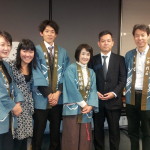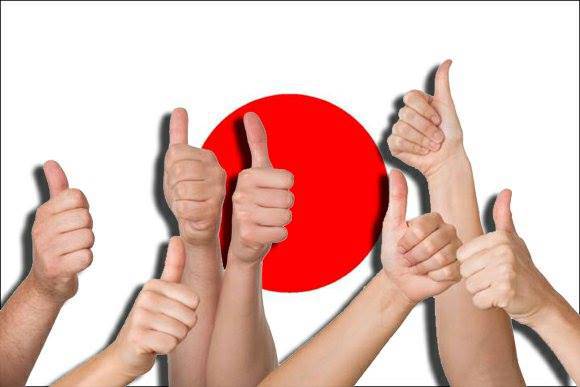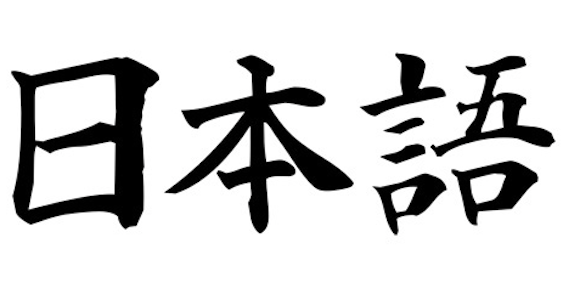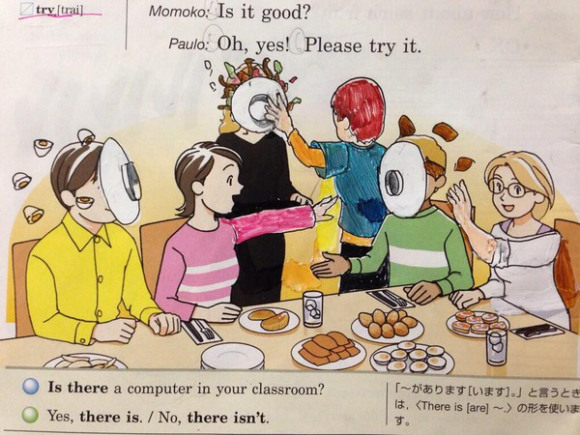【RocketNews24】Why does the fifty yen coin have a hole? And other fun facts about Japanese coins
Posted by Michelle Lynn Dinh (Shimane-ken, Chibu-mura, 2010–13), editor and writer for RocketNews24. The following article was written by Master Blaster, writing team for RocketNews24, a Japan-based site dedicated to bringing fun and quirky news from Asia to English speaking audiences.
A fun way to get a perspective on another country’s history and culture is by looking at the currency used. The materials and design that go into making them can say a lot about what a country holds dear.
So, why don’t we take a quick look through the modern coins used in Japan and learn a little about why they look the way they do and some other tidbits along the way such as what happens when you microwave a one-yen coin and why you shouldn’t do it.
I’ll Make It Myself!: Japan-Friendly Thanksgiving Recipe Ideas
Leah Zoller (CIR Ishikawa-ken, Anamizu, 2009-11) is the editor of The Ishikawa JET Kitchen: Cooking in Japan Without a Fight. She works in international student exchange; writes I’ll Make It Myself!, a blog about food culture in Japan and the US; curates The Rice Cooker Chronicles, a series of essays by JETs and JET alumni on the theme of cooking/eating and being alone in Japan; and admins The JET Alumni Culinary Group on LinkedIn.
Hosting two Thanksgivings in Japan taught me to love the holiday and its food again. My friends are amazing cooks, and the sheer sense of community, of getting together to remake a tradition in our own way really made the holiday feel special.
Last year, I did a recipe-roundup of our meal. This year, I’d like to offer more recipes and suggestions for making Thanksgiving special in Japan or wherever you are.
WIT Life #254: Denver’s Japanese influence
WIT Life is a periodic series written by professional Writer/Interpreter/Translator Stacy Smith (Kumamoto-ken CIR, 2000-03). She starts her day by watching Fujisankei’s newscast in Japanese, and here she shares some of the interesting tidbits and trends along with her own  observations.
observations.
My interpreting travels bring me again to Denver, and earlier in the fall I posted here about the city’s amazing History Colorado Center, currently showing an exhibit about Japanese American internment during the war. It is still running, so make sure to check it out if you are in town! My clients and I spent the first week of our three-week journey in DC, as these Department of State programs always do. There I spent some time at the Memorial to Japanese-American Patriotism in World War II. It features two Japanese cranes caught in barbed wire on top of a tall marble pedestal, and it was created by Japanese-American sculptor Nina Akamu in 2000. It sits in a landscaped plaza surrounded by a granite wall with inscriptions of the battles that Japanese Americans fought in, as well as the names of Read More
【RocketNews24】Japanese elementary school teachers may tell you “5 x 100 = 500” is wrong
Posted by Michelle Lynn Dinh (Shimane-ken, Chibu-mura, 2010–13), editor and writer for RocketNews24. The following article was written by Master Blaster, writing team for RocketNews24, a Japan-based site dedicated to bringing fun and quirky news from Asia to English speaking audiences.
Here’s an elementary school math question for you all:
Apples are sold for 100 yen each. If you buy 5 what is the total amount?
If you said “5 × 100 = 500” then I’m sorry but you just flunked second grade math in Japan… if there were only one question all year. The reason is an old teaching method that is employed in elementary and middle schools throughout the country. It’s also a method that many, such as a blogger by the name of Uncorrelated, want stopped as it leads to strange logic where six times seven does not always equal 42 and five times 100 might not equal 500.
I’ll Make It Myself!: Millet Muffins
L.M. Zoller (CIR Ishikawa-ken, Anamizu, 2009-11) is the editor of The Ishikawa JET Kitchen: Cooking in Japan Without a Fight. Ze works in international student exchange; writes I’ll Make It Myself!, a blog about food culture in Japan and the US; curates The Rice Cooker Chronicles, a series of essays by JETs and JET alumni on the theme of cooking/eating and being alone in Japan; and admins The JET Alumni Culinary Group on LinkedIn.
Check out the rice section in your local supermarket in Japan for other grains, and you’re often find zakkoku (雑穀) / kokumotsu (穀物), mixed grains and beans, which often includes millet. Millet is called awa (粟) or kibi (キビ) and is often sold by itself as uruchikibi (うるちキビ ) or mochi kibi (モチキビ).
【RocketNews24】10 things Japan gets awesomely right
Posted by Michelle Lynn Dinh (Shimane-ken, Chibu-mura, 2010–13), editor and writer for RocketNews24. The following article was written by Philip Kendall (Fukushima-ken, Shirakawa-shi, 2006–11), senior editor and writer for RocketNews24, a Japan-based site dedicated to bringing fun and quirky news from Asia to English speaking audiences.
At the end of our recent article listing the 10 things that we think Japan gets horribly wrong, we assured you that we’d be back soon to focus on some of the positives and introduce the things that we really, truly love about living in Japan. True to our word, we sat down and decided on what we as (mostly) foreigners most love about this great little collection of islands, and it turned out to be a lot of fun.
Although Japan is not without its faults, it is nevertheless an incredibly efficient and easy-to-live-in country, and we’ve discovered that there are numerous things that the Japanese get not just right, but awesomely right.
Join us after the jump for our top 10 things we love about Japan.
WIT Life #253: Preserving Japanese Traditional Arts
WIT Life is a periodic series written by professional Writer/Interpreter/Translator Stacy Smith (Kumamoto-ken CIR, 2000-03). She starts her day by watching Fujisankei’s newscast in Japanese, and here she shares some of the interesting tidbits and trends along with her own observations.
This week I had the opportunity to interpret for a Japanese delegation comprised of two groups who traveled to New York to receive the annual Tiffany Foundation Award. This award was created by the Tiffany Foundation in collaboration with the Japan Center for International Exchange (JCIE), and it recognizes non-profits that are preserving Japanese traditional arts at the national and regional community levels. This year’s recipients were the Association for the Promotion of Ipponsugi Street, located in Ishikawa Prefecture, and envisi, located in Miyagi Prefecture. They were the 6th round of winners since the award’s establishment in late 2007.
The Association for the Promotion of Ipponsugi Street, whose members are featured here wearing the happi coats, preserves their city Nanao’s unique custom of 花嫁のれん (hanayome noren). Noren are long curtains that hang in the entrances to Japanese restaurants and traditional Japanese rooms, and the special bridal ones are dyed using the Kaga yuzen technique. Hanayome noren are hung in the doorway leading to the butsuma (a small room holding sacred objects) for the bride to walk through when she gets married, a ritual that Read More
【RocketNews24】10 things Japan gets horribly wrong
Posted by Michelle Lynn Dinh (Shimane-ken, Chibu-mura, 2010–13), editor and writer for RocketNews24. The following article was written by Philip Kendall (Fukushima-ken, Shirakawa-shi, 2006–11), senior editor and writer for RocketNews24, a Japan-based site dedicated to bringing fun and quirky news from Asia to English speaking audiences.
It should come as no surprise to our readers to hear that we’re big fans of Japan. Pretty much everything here works as it should, the food is amazing, the culture rich, and people are on the whole likeable and friendly. But there are times when Westerners, and Japanese who have spent any amount of time abroad for that matter, realise that Japan gets some things not just wrong but horribly wrong. So join us after the jump as we redress the balance no doubt offset by our constant admiration of Japan by discussing the 10 little things that drive us nuts in this otherwise great country.
【RocketNews24】Acronyms and in-jokes: The origins of your favourite Japanese video game companies’ names
Posted by Michelle Lynn Dinh (Shimane-ken, Chibu-mura, 2010–13), editor and writer for RocketNews24. The following article was written by Philip Kendall (Fukushima-ken, Shirakawa-shi, 2006–11), senior editor and writer for RocketNews24, a Japan-based site dedicated to bringing fun and quirky news from Asia to English speaking audiences.
As much as we like to think of ourselves as free thinkers and immune to corporate advertising, there’s no denying that brand names have found their way into pretty much every facet of our daily lives. Many North Americans routinely use “Kleenex” in place of the word tissue; in the UK it’s not unusual to hear people say that they’re about to “hoover up” when referring to running a vacuum cleaner; and in its heyday pretty much any portable gaming device was casually referred to as a Gameboy.
The likes of Nintendo and Sony have been household names for years, but did you ever wonder where these names come from and what they might mean in their native language? Author of Japanmanship and game developer James Kay sheds some light on the origins of the names Japan’s biggest video game companies use, from Capcom to SNK, and has generously shared a few snippets of info with RocketNews24 for our enjoyment and nerdy enlightenment.
Find out where those world-famous names really come from after the jump.
WIT Life #252: Ivan Ramen
WIT Life is a periodic series written by professional Writer/Interpreter/Translator Stacy Smith (Kumamoto-ken CIR, 2000-03). She starts her day by watching Fujisankei’s newscast in Japanese, and here she shares some of the interesting tidbits and trends along with her own observations.
I can’t believe it’s been over a month since I’ve written here, but during that time I’ve traveled from Hawaii to LA to NY and then to Japan for various interpreting gigs. Needless to say, there were many adventures along the way! A particular highlight was getting to interpret for my favorite Japanese director, Hirokazu Kore-eda, when his fabulous new film Like Father Like Son (そして父になる) debuted at the New York Film Festival last month. It will have its widespread release here in the States early next year, and I will write more about it and meeting the director then…
It’s always great to be home again, and one of the best parts is being able to enjoy the many events taking place on a daily basis here in th e city. Last night I was able to check out one at Strand Books, which hosted the author Ivan Orkin to talk about his experiences running a ramen shop in Tokyo, his new memoir/cookbook, and the opening of his upcoming ramen shop here in NY. I was looking forward to meeting Orkin as he graduated from Read More
e city. Last night I was able to check out one at Strand Books, which hosted the author Ivan Orkin to talk about his experiences running a ramen shop in Tokyo, his new memoir/cookbook, and the opening of his upcoming ramen shop here in NY. I was looking forward to meeting Orkin as he graduated from Read More
【RocketNews24】Ninja life skills: 7 tips to make learning Japanese that little bit easier
Posted by Michelle Lynn Dinh (Shimane-ken, Chibu-mura, 2010–13), editor and writer for RocketNews24. The following article was written by Philip Kendall (Fukushima-ken, Shirakawa-shi, 2006–11), senior editor and writer for RocketNews24, a Japan-based site dedicated to bringing fun and quirky news from Asia to English speaking audiences.
Despite its apparent difficulty, Japanese is fast becoming one of the world’s most desirable languages to learn, with more and more Westerners studying it every day. Eventually, though, we all hit a wall with our studies and feel like we’re not making any progress. The books you threw yourself into with such enthusiasm start to become a chore to open, the army of kanji characters you have yet to study stare back at you with mocking disdain, and despite all the hours you put in you still can’t quite keep up with that anime you were determined to watch without subtitles. It happens to the best of us, but there are ways to break out of this rut, not to mention rekindle that love for studying Japanese, or any other language for that matter.
So today we’d like to bring you our short list of tips and tricks for boosting your Japanese language ability and make studying less of a chore. The following is a combination of both tips and experiences of foreigners who have achieved varying degrees of fluency in the language and our combined knowledge. It’s by no means the final word in language study, but give some of these a try and we’re sure you’ll be surprised at how quickly your Japanese proficiency improves.
I’ll Make It Myself!: Mister Donut Halloween Donuts 2013
L.M. Zoller (CIR Ishikawa-ken, Anamizu, 2009-11) is the editor of The Ishikawa JET Kitchen: Cooking in Japan Without a Fight. Ze works in international student exchange; writes I’ll Make It Myself!, a blog about food culture in Japan and the US; curates The Rice Cooker Chronicles, a series of essays by JETs and JET alumni on the theme of cooking/eating and being alone in Japan; and admins The JET Alumni Culinary Group on LinkedIn.
Last year’s Halloween-themed pumpkin-flavored Mister Donuts doughnuts were delicious. This year, they’ve added a ghost and Hello Kitty shapes, and it appears that the batter is normal but the icing is kabocha-chocolate flavored.
【RocketNews24】Feel better fast: Eight home remedies from the little old ladies of Japan
Michelle Lynn Dinh (Shimane-ken, Chibu-mura, 2010–13) is an editor and writer for RocketNews24, a Japan-based site dedicated to bringing fun and quirky news from Asia to English speaking audiences.
The only thing worse than catching a cold is feeling like you’re about to catch a cold. That achiness you can feel in your bones, followed by dread, worry and the thought, “I’m too busy to get sick now!” It’s enough to make you sick on the spot.
But fear not, the grandmothers of Japan have a plethora of home remedies that’ll get you feeling better in no time. Some may be little more than old wives’ tales, but when you’re feeling under the weather, why not drink hot onion water or smear ginger on your forehead. It actually might be good for what ails you.
I’ll Make It Myself!: Halloween Kit Kats 2013: Where’s the Pumpkin?
L.M. Zoller (CIR Ishikawa-ken, Anamizu, 2009-11) is the editor of The Ishikawa JET Kitchen: Cooking in Japan Without a Fight. Ze works in student exchange; writes I’ll Make It Myself!, a blog about food culture in Japan and the US; curates The Rice Cooker Chronicles, a series of essays by JETs and JET alumni on the theme of cooking/eating and being alone in Japan; and admins The JET Alumni Culinary Group on LinkedIn.
Halloween Kit Kats in Japan and US.
Let’s enjoy Halloween!
A standard Halloween dessert, pumpkin pudding has a sweet and gentle flavor that fills the mouth. Enjoy Halloween even more with pumpkin-pudding flavor Kit Kats. (Nestle Kit Kats Mini Pumpkin Pudding Flavorネスレ キットカット ミニ パンプキンプリン味)
【RocketNews24】Possibly the greatest textbook doodles of all time
Michelle Lynn Dinh (Shimane-ken, Chibu-mura, 2010–13) is an editor and writer for RocketNews24, a Japan-based site dedicated to bringing fun and quirky news from Asia to English speaking audiences.
Remember back in high school when you’d opened up your textbook to find George Washington picking his nose and Joseph Stalin with a peg leg and eye patch. It was enough to make you bow down and thank the graffiti gods for giving you a much needed distraction from the incessant ramblings of your instructor.
Textbook doodles seem to transcend national borders and bored students from all over the world appear to have a penchant for defiling educational tools. We’ve already shown you some from Asia, a continent that seems to be home to an abundance of bored students with idle hands. Now let’s take a look at textbook doodles from Twitter user and Japanese high school student, Chanta, who takes it to a whole other level, actually erasing parts of his textbook to create entirely different, albeit twisted, pictures. Former and current JETs might appreciate Chanta’s preference for using his English textbook as his canvas.













